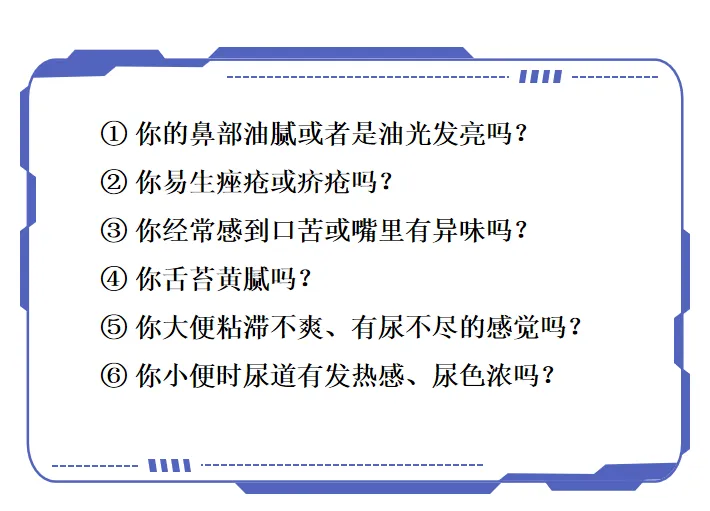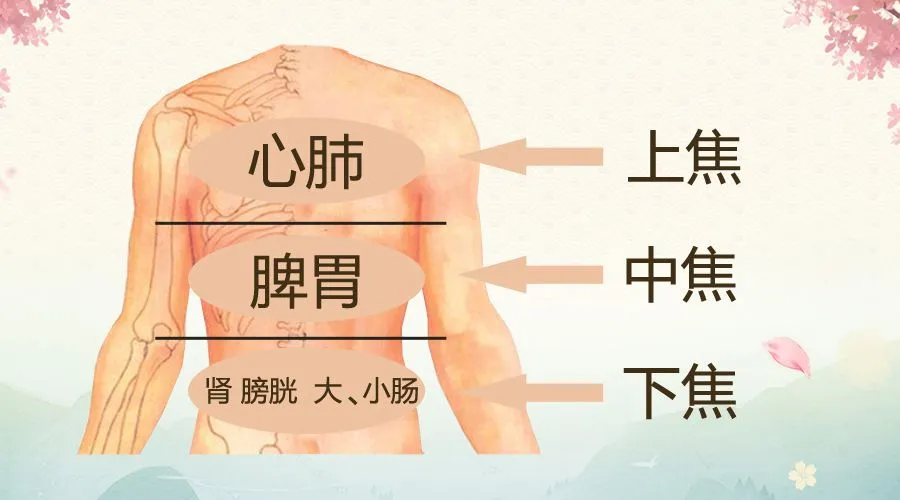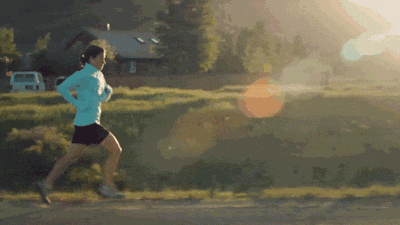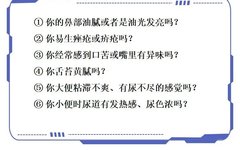When you notice a decline in your appearance,
it is essential to be alert to the possibility of damp-heat issues within your body.
Just like blue skies encountering dark clouds,
our beauty can be overshadowed by a layer of gloom.
How can you determine if you have damp-heat in your body?

Individuals with damp-heat in their bodies
will exhibit four characteristics: heat, odor, yellow, and sticky.
If you meet four or more of these criteria,
it is highly likely that you belong to the damp-heat constitution.

Traditional Chinese Medicine (TCM) believes that damp-heat is the root cause of issues such as oily hair and skin, acne, rosacea, enlarged pores, hair loss, and body shape changes. If appropriate methods are not taken to eliminate damp-heat from the body, your appearance will suffer significantly!
Five Major Manifestations of Damp-Heat
1
Yellowing of the Sclera
One can assess health through the eyes, as they are connected to the body’s meridians, and the essence of the five organs is reflected in the eyes. A healthy person has clear, bright eyes with a distinct separation between the sclera and the iris. According to the theory of the five wheels, the iris is associated with the liver. If your iris appears slightly yellow (not jaundice), along with frequent eyelid swelling and excessive eye discharge, it is certainly due to damp-heat in the liver meridian.
2
Oily Skin, Enlarged Pores, and Acne
 The skin is an important channel for detoxification. Excess substances in the body often need to be expelled through countless pores in the skin. When damp-heat accumulates, even numerous pores are insufficient, leading to oily skin, enlarged pores, and acne. If the nostrils are also red, or if rosacea is present, it indicates damp-heat in the spleen and stomach.
The skin is an important channel for detoxification. Excess substances in the body often need to be expelled through countless pores in the skin. When damp-heat accumulates, even numerous pores are insufficient, leading to oily skin, enlarged pores, and acne. If the nostrils are also red, or if rosacea is present, it indicates damp-heat in the spleen and stomach.
3
Chloasma
Chloasma, also known as “liver spots,” is primarily related to three factors: liver qi stagnation, internal damp-heat, and yin deficiency with excess fire. If you have spots on your face accompanied by symptoms such as chest tightness, rib pain, heaviness, fatigue, sticky stools, and poor appetite, it indicates that you are suffering from liver-spleen disharmony and internal damp-heat, requiring heat-clearing, dampness-eliminating, and liver-soothing treatments.
4
Reproductive System Inflammation and Strong Body Odor
Women typically have a special fragrance, but those with liver meridian heat will have this fragrance replaced by a fishy odor. This is because the liver meridian descends through the genital area, and the damp-heat in the liver meridian can invade the genital area, providing a breeding ground for bacteria and parasites, leading to symptoms such as genital itching, increased vaginal discharge, and abnormal odor. Men are prone to strong body odor, scrotal dampness, scrotal eczema, and prostatitis. Additionally, inflammation in the vulva and urethra can easily lead to urinary tract infections, such as frequent urination, urgency, pain during urination, and if this occurs frequently, it can easily induce nephritis.
Additionally, inflammation in the vulva and urethra can easily lead to urinary tract infections, such as frequent urination, urgency, pain during urination, and if this occurs frequently, it can easily induce nephritis.
5
Side Pain
What we commonly refer to as side pain is actually pain in the ribs. Individuals with poor mood and significant emotional fluctuations tend to have liver qi stagnation, and the damp-heat generated by the spleen is most likely to accumulate in the liver, causing damp-heat in the liver meridian and rib pain.
In addition to the five manifestations mentioned above, damp-heat in the liver meridian can also cause bloating, poor appetite, aversion to food, bitter mouth, nausea with an inability to vomit, and dark yellow urine with a burning sensation.
The harm of damp-heat in the body is not only about becoming overweight and unattractive!
It can also lead to…
Damp-heat stagnating in the organs and meridians not only obstructs the flow of qi but also damages yang qi, significantly affecting blood, qi, and body fluids. Blood lipids, blood sugar, and blood viscosity are all influenced by damp-heat, and common conditions such as hypertension, hyperlipidemia, diabetes, and fatty liver are also related to damp-heat.
How to prevent and regulate damp-heat constitution?
1
Shape the constitution from the fetal stage
A mother’s damp-heat constitution can be passed on to her child. Many infants exhibit symptoms such as oral ulcers, eczema, constipation, and heat during infancy, which are related to the mother’s constitution and diet during pregnancy.
It is recommended that women of childbearing age regulate their constitution before pregnancy; during pregnancy, scientifically manage fetal nurturing and education to give the child a head start.
2
Alcohol is a major contributor to damp-heat
 Damp-heat constitution is closely related to alcohol! You will notice that after drinking, your breath becomes stronger, and if you have eczema or athlete’s foot, it becomes itchier… This is because alcohol promotes damp-heat. Regularly drinking or consuming large amounts of alcohol is a significant factor contributing to damp-heat constitution. To improve damp-heat constitution, one should reduce alcohol consumption.
Damp-heat constitution is closely related to alcohol! You will notice that after drinking, your breath becomes stronger, and if you have eczema or athlete’s foot, it becomes itchier… This is because alcohol promotes damp-heat. Regularly drinking or consuming large amounts of alcohol is a significant factor contributing to damp-heat constitution. To improve damp-heat constitution, one should reduce alcohol consumption.
3
Regulation
Regulate the spleen and stomach
 The spleen governs the earth and is responsible for transformation. A strong spleen prevents dampness from stagnating. Regulating damp-heat constitution requires a reasonable diet and strengthening the spleen and stomach. Consider the following factors:
The spleen governs the earth and is responsible for transformation. A strong spleen prevents dampness from stagnating. Regulating damp-heat constitution requires a reasonable diet and strengthening the spleen and stomach. Consider the following factors:
▶ The spleen prefers warmth and dislikes cold; it likes dryness and dislikes dampness.
Individuals with damp-heat constitution should eat less: spicy, greasy, sweet foods, hot pot, barbecued, and fried foods, and avoid overeating; they can eat more: Portulaca oleracea (Ma Chi Xian), Coix seed (Yi Yi Ren), winter melon, Chinese cabbage, Poria (Fu Ling), lotus seeds, etc.
▶ The liver belongs to wood, and wood overcomes earth.
It is essential to smooth liver qi to harmonize the liver and spleen. Irritability, staying up late, excessive stress, and overthinking can lead to qi stagnation, liver-spleen disharmony, and increased dampness. Those with damp-heat constitution should learn to manage their emotions; when faced with unpleasant situations, it is advisable to temporarily leave the scene, change the environment, and restore emotional calm and stability.
▶ The spleen governs the limbs; exercise helps expel dampness through sweating.
Individuals with damp-heat constitution should engage in regular exercise to induce sweating, which can help promote yang qi and prevent dampness from stagnating. Hiking, various ball games, martial arts, and square dancing are excellent choices.

4
Utilize
A simple formula for easy regulation

San Ren Tang (Three Nut Decoction) is a formula written by the TCM master Wu Ju Tong in the Qing Dynasty in his work “Wen Bing Tiao Bian,” specifically used to address damp-heat syndrome.
Original formula composition: apricot kernel (Xing Ren), white cardamom (Bai Dou Kou), coix seed (Yi Yi Ren), pinellia (Ban Xia), magnolia bark (Hou Po), talc (Hua Shi), reed rhizome (Tong Cao), bamboo leaves (Zhu Ye).
By opening and dispersing the upper jiao, promoting the middle jiao, and draining the lower jiao, it effectively addresses damp-heat in the three jiao.In simple terms, it utilizes the properties of the herbs to simultaneously attack damp-heat from the upper, middle, and lower jiao, achieving the goal of eliminating damp-heat.
First, the upper jiao: Apricot kernel can disperse lung qi, allowing the lung’s qi mechanism to flow smoothly. When lung function is normal, the lung governs the skin and hair, enabling it to expel damp-heat through the skin. When the damp-heat trapped in the skin is eliminated, the upper jiao naturally becomes unobstructed.
Next, the middle jiao: This is where white cardamom comes in, which can transform turbidity, awaken the spleen, and promote qi. Under the stimulation of white cardamom, the spleen and stomach will be activated, and once the spleen and stomach begin to function, the clear will rise, and the turbid will descend, naturally eliminating dampness.
However, this is not the end. Although our body has dampness in the upper, middle, and lower jiao, the primary dampness is in the middle jiao, as the spleen and stomach are the source of all dampness. Therefore, the task of regulating damp-heat in the middle jiao is quite challenging. Simply relying on white cardamom may be insufficient, so the formula also includes magnolia bark and pinellia.
Magnolia bark is bitter and warm; warmth promotes flow, and bitterness descends, which can move qi and dry dampness. The characteristic of magnolia bark is its strong downward action, which can expel dampness from the middle jiao through bowel movements. Meanwhile, pinellia can dry dampness and transform phlegm. The reason for adding pinellia is that prolonged dampness will inevitably lead to phlegm formation, and once phlegm is formed, it becomes more challenging to eliminate. Therefore, pinellia is used to prevent phlegm-damp from further harming the body.
Finally, the lower jiao: This is where coix seed shines. According to “Ben Cao Xin Bian”: “Coix seed is best for promoting urination without damaging true yin qi. For those with excess dampness in the lower body, it is most suitable. Depending on the severity of the condition, the dosage can be adjusted, ensuring that yin and yang are not harmed while dampness is easily eliminated. Therefore, for any water-damp symptoms, using one or two taels of coix seed as the main ingredient, along with flavors that strengthen the spleen and eliminate dampness, will yield quick results. If the flavor is too mild and used sparingly, it will be of no benefit.” This shows that coix seed’s most prominent ability is to promote urination and drain dampness, particularly in the lower jiao.

Consultation | Inquiry | Communication
Please click

© Zheyan Looks at Traditional Chinese Medicine

Long press the QR code below to follow us


Discussing Medicine and Philosophy, Inheriting the Qi Huang
Exploring Depths and Seeking Hidden Meanings

Please indicate the source when reprinting
Some content is sourced from the internet, and copyright belongs to the original author
If there is any infringement, please contact for removal

Medical Path Origin
If interested, please click the lower right corner; we have youin view

